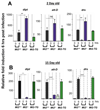Drosophila DNA/RNA methyltransferase contributes to robust host defense in aging animals by regulating sphingolipid metabolism
- PMID: 30254027
- PMCID: PMC6258898
- DOI: 10.1242/jeb.187989
Drosophila DNA/RNA methyltransferase contributes to robust host defense in aging animals by regulating sphingolipid metabolism
Abstract
Drosophila methyltransferase (Mt2) has been implicated in the methylation of both DNA and tRNA. In this study, we demonstrate that loss of Mt2 activity leads to an age-dependent decline of immune function in the adult fly. A newly eclosed adult has mild immune defects that are exacerbated in a 15 day old Mt2-/- fly. The age-dependent effects appear to be systemic, including disturbances in lipid metabolism, changes in cell shape of hemocytes and significant fold-changes in levels of transcripts related to host defense. Lipid imbalance, as measured by quantitative lipidomics, correlates with immune dysfunction, with high levels of immunomodulatory lipids, sphingosine-1-phosphate (S1P) and ceramides, along with low levels of storage lipids. Activity assays on fly lysates confirm the age-dependent increase in S1P and concomitant reduction of S1P lyase activity. We hypothesize that Mt2 functions to regulate genetic loci such as S1P lyase and this regulation is essential for robust host defense as the animal ages. Our study uncovers novel links between age--dependent Mt2 function, innate immune response and lipid homeostasis.
Keywords: Ceramide; Hemocyte; Innate immunity; Invertebrate; Lipid homeostasis; Mt2; Signaling; Sphingosine-1-phosphate (S1P).
© 2018. Published by The Company of Biologists Ltd.
Conflict of interest statement
Competing interestsThe authors declare no competing or financial interests.
Figures





References
-
- Abel T, Michelson AM, Maniatis T. A Drosophila GATA family member that binds to Adh regulatory sequences is expressed in the developing fat body. Development. 1993;119:623–33. - PubMed
-
- Adada MM, Canals D, Jeong N, Kelkar AD, Hernandez-Corbacho M, Pulkoski-Gross MJ, Donaldson JC, Hannun YA, Obeid LM. Intracellular sphingosine kinase 2-derived sphingosine-1-phosphate mediates epidermal growth factor-induced ezrin-radixin-moesin phosphorylation and cancer cell invasion. FASEB J. 2015;29:4654–69. - PMC - PubMed
-
- Agaisse H, Petersen UM, Boutros M, Mathey-Prevot B, Perrimon N. Signaling role of hemocytes in Drosophila JAK/STAT-dependent response to septic injury. Dev Cell. 2003;5:441–50. - PubMed
-
- Akira S, Uematsu S, Takeuchi O. Pathogen recognition and innate immunity. Cell. 2006;124:783–801. - PubMed
Publication types
MeSH terms
Substances
Grants and funding
LinkOut - more resources
Full Text Sources
Other Literature Sources
Medical
Molecular Biology Databases

